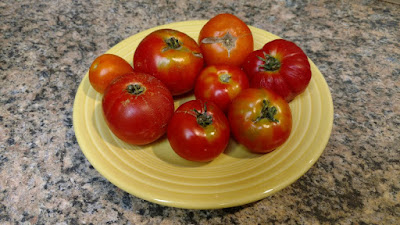Ripe alert: Tomatoes go red as temperatures rise
What happens to tomatoes when days hit 100 degrees
By Debbie Arrington
On days like these, tomatoes can go from nearly perfect to squishy messes.
Our current summer heat wave does more than make us sweat. It speeds up ripeness in several crops, most notably tomatoes.
We may notice it most in tomatoes because we tend to be fixated on them in these first days of summer. We welcome the summer weather because, as gardeners, it kick starts summer vegetables into high gear.
But if temperatures get too hot for too long, tomatoes can go from almost ready to over the top.
Rapid development brings other issues; cracking and splits, blossom end rot, tomato-eating pests.
Or tomatoes may stop developing at all. Tomato flowers won't set fruit if temperatures get too high, particularly if night temperatures stay above 75 degrees F.
What if the plant is loaded with green fruit? According to university research, tomatoes stop or slow down ripening if temperatures exceed 90 degrees for prolonged periods of time.
According to Bonnie Plants, tomatoes have difficulty producing red pigments in temperatures above 95 degrees; ripe tomatoes may be orange or streaked with orange in all-red varieties.
In the Sacramento area, cooler nights and the Delta breeze usually rescue the tomato crop and the vines keep producing even as temperatures rise. But determinate varieties (such as Celebrity or Bush Early Girl) will ripen all at once, even if the fruit is small.
If a heat spell with several days over 100 degrees is predicted, harvest tomatoes that are close to ready or showing a lot of color as well as ripe ones, say experts. Those not-quite-ready tomatoes will ripen better on the counter than the vine.
Too much sun can sunburn tomato shoulders; allow the foliage to shade the fruit or erect some sort of shade structure over the tomato vines (such as burlap draped atop the tomato cage or supports). Leave the side facing east open to full morning sun, but protect the plant from the hottest afternoon sun from the west and south. This afternoon shade benefits the whole vine as well as the ripening fruit.
Below the plant, mulch helps keep roots cool and retains moisture. Deep watering, preferably in the early morning, keeps plants hydrated.
Afternoon wilt is common in many tomato varieties on 100-degree afternoons. But if vines look wilted in the morning, give them a drink.
Daily tomato checks become routine this time of year. How is each vine coping with the heat?
On the bright side: You're harvesting fresh ripe tomatoes! Enjoy!
By Debbie Arrington
On days like these, tomatoes can go from nearly perfect to squishy messes.
Our current summer heat wave does more than make us sweat. It speeds up ripeness in several crops, most notably tomatoes.
We may notice it most in tomatoes because we tend to be fixated on them in these first days of summer. We welcome the summer weather because, as gardeners, it kick starts summer vegetables into high gear.
But if temperatures get too hot for too long, tomatoes can go from almost ready to over the top.
Rapid development brings other issues; cracking and splits, blossom end rot, tomato-eating pests.
Or tomatoes may stop developing at all. Tomato flowers won't set fruit if temperatures get too high, particularly if night temperatures stay above 75 degrees F.
 |
| These tomatoes ripened rapidly with some splits and orange shoulders from the high heatd. |
What if the plant is loaded with green fruit? According to university research, tomatoes stop or slow down ripening if temperatures exceed 90 degrees for prolonged periods of time.
According to Bonnie Plants, tomatoes have difficulty producing red pigments in temperatures above 95 degrees; ripe tomatoes may be orange or streaked with orange in all-red varieties.
In the Sacramento area, cooler nights and the Delta breeze usually rescue the tomato crop and the vines keep producing even as temperatures rise. But determinate varieties (such as Celebrity or Bush Early Girl) will ripen all at once, even if the fruit is small.
If a heat spell with several days over 100 degrees is predicted, harvest tomatoes that are close to ready or showing a lot of color as well as ripe ones, say experts. Those not-quite-ready tomatoes will ripen better on the counter than the vine.
Too much sun can sunburn tomato shoulders; allow the foliage to shade the fruit or erect some sort of shade structure over the tomato vines (such as burlap draped atop the tomato cage or supports). Leave the side facing east open to full morning sun, but protect the plant from the hottest afternoon sun from the west and south. This afternoon shade benefits the whole vine as well as the ripening fruit.
Below the plant, mulch helps keep roots cool and retains moisture. Deep watering, preferably in the early morning, keeps plants hydrated.
Afternoon wilt is common in many tomato varieties on 100-degree afternoons. But if vines look wilted in the morning, give them a drink.
Daily tomato checks become routine this time of year. How is each vine coping with the heat?
On the bright side: You're harvesting fresh ripe tomatoes! Enjoy!


Comments
Post a Comment